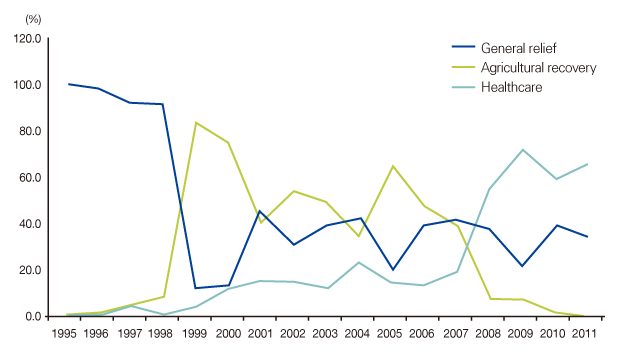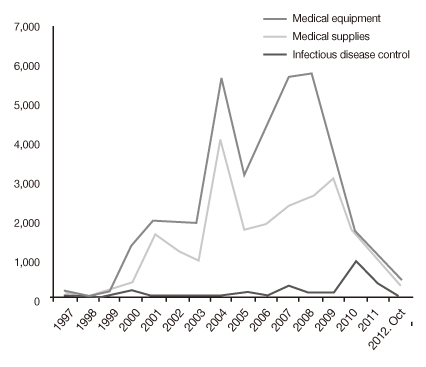J Korean Med Assoc.
2013 May;56(5):375-382.
Current status and prospects of exchange of health officials from South and North Korea through non-governmental organizations
- Affiliations
-
- 1Department of Social Welfare, Gachon University, Seongnam, Korea.
- 2Growth and Development Center, Shinheung College, Uijeongbu, Korea.
- 3Department of Medical Law and Ethics, Yonsei University College of Medicine, Seoul, Korea. arete2@yuhs.ac
- 4Asian Institute for Bioethics and Health Law, Yonsei University, Seoul, Korea.
Abstract
- South Korea's health care non-governmental organizations (NGOs) have played a crucial role in South-North relations, for a formal intergovernmental relationship is difficult to establish and also easily breaks down. Humanitarian assistance by NGOs in the health care sector is an area that receives wide support from South Korean society for its urgency and for its appeal to humanity. This humanitarian assistance started in the late 1990's and continued to grow until the late 2000's. This assistance continued throughout the tension between the two administrations that resulted in a radical decrease in overall assistance from South Korea to North Korea. However, concerns remain about the transparency and efficiency of NGO activities. In this article, the NGOs and their major activities are delineated, and South Korean legislation is examined. A current act, the Law on the Development of South and North Korean Relations serves as a basis for governmental regulation and support of NGO's. Humanitarian assistance in the healthcare area is directly related to the health of the North Korean people, and it should not be influenced by political changes. Long-term planning and close discussions between NGOs, their North Korean counterparts, and the South Korean government are needed. NGOs need to overcome their shortcomings such as a lack of expertise and shortage of financial support. For this, NGOs must improve their administration transparency and professionalism.
Keyword
MeSH Terms
Figure
Reference
-
1. Kim TU. Current status of EU-North Korean diplomatic relation and its political background. J Polit Sci Commun. 2001; 4:229–253.2. Financial Tracking Service. Korea DPR overview of needs and assistance 2012 [Internet]. New York: Financial Tracking Service;2013. cited 2013 Apr 23. Available from: http://fts.unocha.org/reports/daily/ocha_R5_A975___1303280205.pdf.3. Ahan DK. The evaluation of the role of NGOs in the process of interchange and cooperation between North and South Korea. 21st Century Polit Sci Rev. 2007; 17:87–119.
Article4. UN Office for the Coordination of Humantarian Affairs. Peace-building and linkages with humanitarian action: key emerging trends and challenges [Internet]. New York: UN Office for the Coordination of Humantarian Affairs;2011. cited 2013 Apr 23. Available from: http://ochanet.unocha.org/p/Documents/Occasional%20paper%20Peacebuilding.pdf.5. World Health Organization. The World Health Organization report 2007. A safer future: global public health security in the 21st century [Internet]. Geneva: World Health Organization;2007. cited 2013 Apr 23. Available from: http://www.who.int/whr/2007/en/.6. World Food Programme. Overview of needs and assistance: the Democratic People.s Republic of Korea [Internet]. New York: World Food Programme;2012. cited 2013 Mar 20. Available from: http://www.wfp.org/sites/default/files/DPRK%20Overview%20Of%20Needs%20And%20Assistance%202012.pdf.7. Lee J. Ajou Institute of Korean Unification and Health Care. Current healthcare status of North Korea and assistance plan. Korea unification and healthcare. Seoul: Ajou Institute of Korean Unification and Health Care;2007. p. 199–238.8. Ministry of Unification. South Korean assistance to North Korea [Internet]. Seoul: Statistics Korea;2012. cited 2013 Mar 15. Available from: http://www.index.go.kr/egams/stts/jsp/potal/stts/PO_STTS_IdxMain.jsp?idx_cd=2784.9. Lee JM. Korea Foundation for International Healthcare. Plan for cooperation between governmental-nongovernmental sector for North Korean ODA. Proceedings of Issues and Plans in North Korea Healthcare Developmental Assistance. 2008 Jul 28; Seoul, Korea. Seoul: Korea Foundation for International Healthcare;2008. p. 4.10. Lee JM. Manuscript for international system of humanitarian assistance for North Korea and its implication for South Korea: present and future of North Korea assistance from international sect [Internet]. Seoul: 2004. cited 2013 Mar 20. Adventist Development and Relief Agency;Available from: http://www.nkchannel.org/contents/?doc=bbs/gnuboard.php&bo_table=pds&sselect=wr_name&stext=%.11.11. Medical Aid for Children. Annual healthcare report 2012. Seoul: Medical Aid for Children;2012.12. Lee CS, Kim SY, Lee I. Current status of North Korea assist-ance NGO's and future direction. Seoul: Ajou Institute of Korean Unification and Health Care;2008.13. Ministry of Unification. North Korea healthcare aid by category 1997 to 2012, October [Internet]. Seoul: Ministry of Unification;cited 2013 Mar 20. Available from: http://www.unikorea.go.kr.14. Choi CY. Korea NGO Council for Cooperation with North Korea. Trend of national legislation on humanitarian assistance for North Korea. Proceedings of the Subcommittee for Legislation of North Korea Humanitarian Assistance, Korea NGO Council for Cooperation with North Korea. 2013 Apr 5; Seoul, Korea. Seoul: Korea NGO Council for Cooperation with North Korea;2013. p. 4–5.
- Full Text Links
- Actions
-
Cited
- CITED
-
- Close
- Share
- Similar articles
-
- Changes in health status of North Korean children and emerging health challenges of North Korean refugee children
- North Korean Children's Health and the Role of Maternal and Child Health Experts
- A Study on the Improvement Plan of Public Health Official Training
- A small window into the status of malaria in North Korea: estimation of imported malaria incidence among visitors from South Korea
- The State of the Art of Preventive Medicine in North Korea With Reference to the Content Analysis of a Medical Textbook



